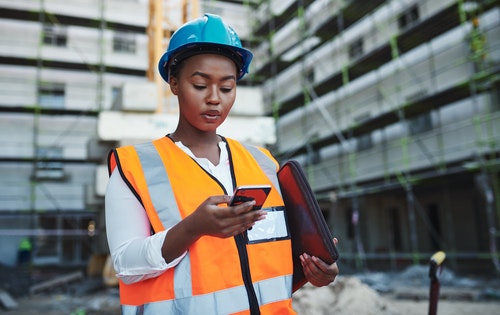Whenever work is done from a certain height, it comes with all kinds of associated hazards. One example of this is roof work.
Roof working comes with all kinds of safety procedures that you, and your staff, must comply with. This will help encourage good safety standards - helping to reduce risks when working from a height.
If you ignore legal requirements, you could end up facing serious consequences. Like injuring workers, paying compensation fines, and even facing business closure.
In this guide, we'll look at how to work on a roof safely, what the law covers, and how to minimise the risks of working at height.
What is roof safety?
Roof safety is a system that prevents injuries and structural damage whilst working on roofs or other high platforms.
These safety measures help to ensure proper precautions are being taken - by you, workers, and the overall business. These steps, not only protect your roof workers, but they safeguard anyone linked to your work area (like other staff or the general public).
Roof working comes with all kinds of risks depending on where it's being done. This applies to changing roof tiles for domestic projects; to building tall infrastructures.
What is the law on roof safety?
When it comes to roof safety, there are various laws that employers must comply with. These apply to both small roofers, as well as the construction industry.
The main laws covering roof safety include:
- The Work at Height Regulations 2005.
- The Health and Safety at Work etc. Act 1974 (HSWA).
- The Management of Health and Safety at Work Regulations 1999 (MHSWA).
- The Construction (Design and Management) Regulations 2007.
- The Lifting Operations and Lifting Equipment Regulations 1998.
- The Provision and Use of Work Equipment Regulations 1998.
The Work at Height Regulations 2005 are referred to the most when it comes to planning work at heights. They outline specific measures to follow, as well as suitable safety equipment to use. For example, a safety harness, safety nets, or roof anchor systems.
Without compliance, roof workers are at risk of serious injury, like punctured limbs, broken bones, and even death from falling. Even if an employer wasn't directly involved in a work-related accident, they hold ultimate responsibility.
Such incidents can lead to workers raising negligence claims to employment tribunal (ET). If their claims are successful, you could face compensation fines, business closure, and even imprisonment (if applicable).
What causes safety risks during roof work?
When it comes to roof work, there are many causes that lead to safety risks. That's why it's important for employers to consider these properly before initiating any work at heights.
Remember, these safety risks are applicable during both domestic and commercial jobs. Let's take a look at what causes safety risks during roof work:
Lack of safe access
The biggest risk is a lack of safe access. This involves more than just having properly secured ladders. Workers must be able to access roofs in the safest way - and that includes entering and exiting roofs.
Access passages should be well-structured; and strong enough to hold the weight of your roof workers, equipment, and other materials. Typical methods that employers use to provide safe access to roofs include:
- Ladders.
- General access scaffolds.
- Fixed or mobile scaffold towers.
- Mobile access equipment.
- Stair towers.
- Roof access hatches.
Unsuitable roof edges and openings
As mentioned, the biggest risk when it comes to roof work is falling from a height. That's why employers must ensure their staff aren't working alongside unsuitable roof edges and openings.
Falls from roof edges occur when there's a lack of necessary control measures in place. The most common falls occur due to unsuitable roof edges, faulty guard-rails, or unmarked openings.
Sloping and flat roofs will require their own type of roof edges. For example, some sloping roofs may secure double guard-rail and toeboard around the edges.
Incorrect safety equipment
It's impossible to work safely if your staff don't have the correct safety equipment at hand.
The type of safety equipment they'll need depends on what the job includes. For example, if they're fixing slate and tile roofs, they'll require proper scaffolding. But if they're simply cleaning out a drainpipe, an extension ladder will do.
Without the proper equipment (and training), roof workers are at risk of serious injury and permanent health damage.
Extreme temperatures
Roof workers are often exposed to extreme weather conditions, especially when they're working over long periods.
In hot temperatures, roof workers may suffer from sunburn or skin damage - potentially leading to skin cancer. During windy or rainy days, they may need to use special equipment (like a roof anchor and rope grab) so they don't slip, trip, or fall from roofs.
In cold temperatures, roof workers may need to wear thicker clothing or multiple layers. This is to combat working in cold conditions for long hours at a time. Without proper prevention, working in cold conditions can lead to increased risk of slips, numbness, and even pneumonia.
Fragile roof surfaces
You can't just assume a brick or sheeted roof can hold the weight of a roof worker. All types of roofs should be treated as fragile surfaces (until a professional person confirms that they aren't).
Before working on fragile roofs, you need to ensure workers have a secure area before stepping onto them. It's also important to have a safe system that deals with the direct platform beneath fragile roofs.
Working on or near fragile roof surfaces requires proper lighting. Insufficient roof lights leads to visibility issues, which is a particular hazard for roof workers. Make sure fragile roofs have proper lights throughout all working hours.
How to work on a roof safely
When it comes to health & safety, the ultimate responsibility falls on the employer.
You must ensure all proper safety measures and procedures are followed before any work is started on roofs. That way, you'll be able to protect your staff, and anyone else linked to your roof work.
Let's take a look at how to safely work on a roof:
Conduct a roof safety risk assessment
The first step you should take is conducting a roof safety risk assessment.
This is especially important when performing jobs with higher risks - like roof working. Your risk assessment should include both minor and major hazards found during projects.
The assessments also help identify certain risks before any work has started. However, it's always best to avoid working at heights if it's possible.(even if it seems more complicated than just getting onto the roof).
Ensure roof workers have correct training
You must ensure your workers have the proper training when it comes to working on roofs.
This includes knowing how to protect themselves whilst working at heights. And ensuring their actions or behaviour don't directly (or indirectly) cause injuries to other people.
Training also helps them when it comes to dealing with a health & safety risk in real time. They should be able to identify, control (within reason), and report the issue to a responsible person.
Provide personal protective equipment (PPE)
Roof workers should be provided with personal protective equipment (PPE) for any jobs that have certain safety risks.
There is a variety of PPE that roof workers may need. For example:
- Appropriate trousers: Trousers protect legs from cuts, grazes, and splinters. It's important not to wear loose or long trousers which can lead to trip hazards.
- Protective footwear: Steel toe-caps shoes protect feet from falling objects. They also prevent injuries caused by puncture or penetration from sharp materials. Proper shoes can also provide secure footing, especially on sloping roofs.
- Knee protection: Knee-pads protect ligaments in the knees, especially during long work hours. They also help minimise compression and depletion to joints.
- High-visibility clothing: Hi-vis clothing helps staff remain visible during work. They're not restricted to construction sites; it's good practice to wear them as an additional safety measure.
- Safety glasses and helmets: Safety glasses help minimise injuries to iris or vision. Helmets protect workers from airborne objects, like flying debris or power lines. They also provide head protection in the case of a fall.
Provide roof edge protection
You must provide good roof edge protection during all working hours. This applies to both domestic and commercial jobs. The requirements will depend on certain factors; for example:
- Main guard-rails need to be at least 950mm above all roof edges.
- Intermediate guard-rails or suitable alternatives need to have gaps bigger than 470mm.
- Toeboards and brick-guards need to be strategically located in order to minimise falling objects and debris.
You can also use parapets as these provide further suitable protection. However, they must be carefully assessed and managed through your risk assessments.
Implement fall restraint procedures
The next step is to implement fall restraint procedures. There are a number of ways you can provide edge protection during roof work.
For example, having safety nets slung beneath roof areas; or using soft landing systems, like bean bags or inflatable air bags.
Roof workers can also be given a personal fall arrest system(like a safety rope) for high risk tasks. Fall arrest systems don't prevent falls, but they do minimise risks of serious injury.
Minimise falling debris and objects
It's not advisable to leave work materials or equipment (like power tools) lying around on construction sites - and it's the same on roofs.
This can cause a risk of falling objects and debris which can lead to serious injuries. Roof workers should never throw objects from a roof or high platform. Make sure they use enclosed rubbish chutes, or lower objects to the ground via containers.
It's also best to prevent access to the area directly underneath or adjacent to your roof work. For example, closing off a public walkway with safety signage and barricades. This can help minimise safety risks to other workers, as well as the general public.
What do professional roofers use for safety?
Professional roofers will generally have a set-list of equipment that helps minimise safety issues.
Safety equipment will usually depend on what type of work is being done. But most professionals will use items, like a roof safety harness, slip-resistant shoes, hard hats, and extension cords (when working on higher platforms).
What about short-duration roof work?
Some types of roof work may not be as high risk as you'd think. It could involve fitting solar panels, fixing a TV aerial, or cleaning moss from a roof.
Although these jobs may not take too long, you still need to follow proper working at height regulations. These minimum requirements for short-duration roof work include:
- Safe access to the roof or other high platforms.
- Using a proper roof ladder that's suitable for the surface (like flat or sloping roofs).
- Prevent slips, trips, and falls (like using a roof anchor to prevent falling from a height).
You might be able to use mobile access equipment, instead of building scaffolding. This is both time and cost-effective when conducting short-duration roof work.
Get expert advice on roof safety with Peninsula
When it comes to working on roofs, there are a number of legal requirements you need to think about. Following these will help minimise injury risks to both workers, as well as other people.
If you ignore legal requirements, you could end up facing serious consequences. Like injuring workers, paying compensation fines, and even facing business closure.
Peninsula offers expert advice on roof safety. Our HR team offers 24/7 HR employment advice which is available 365 days a year.
Want to find out more? Contact one of our HR consultants today. For further support, call our telephone number 0800 028 242.




